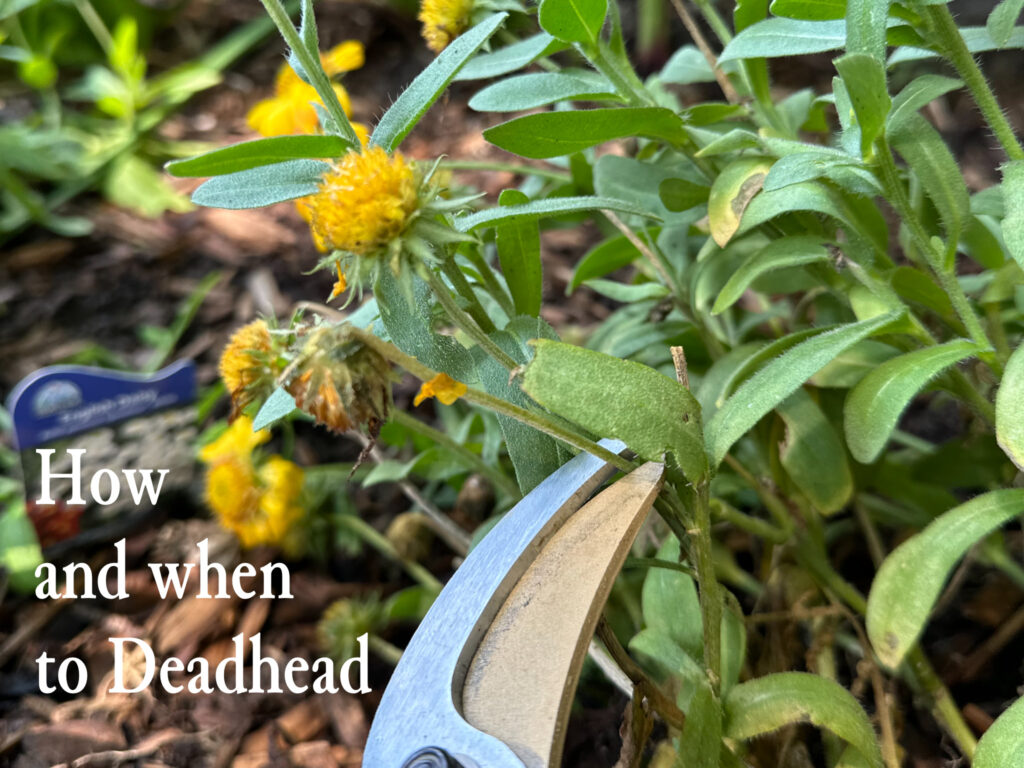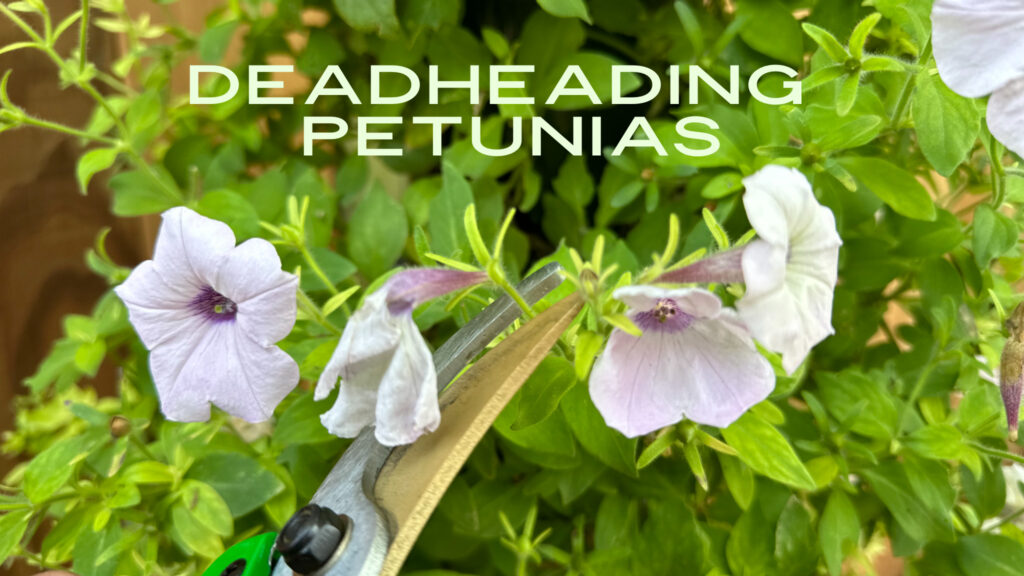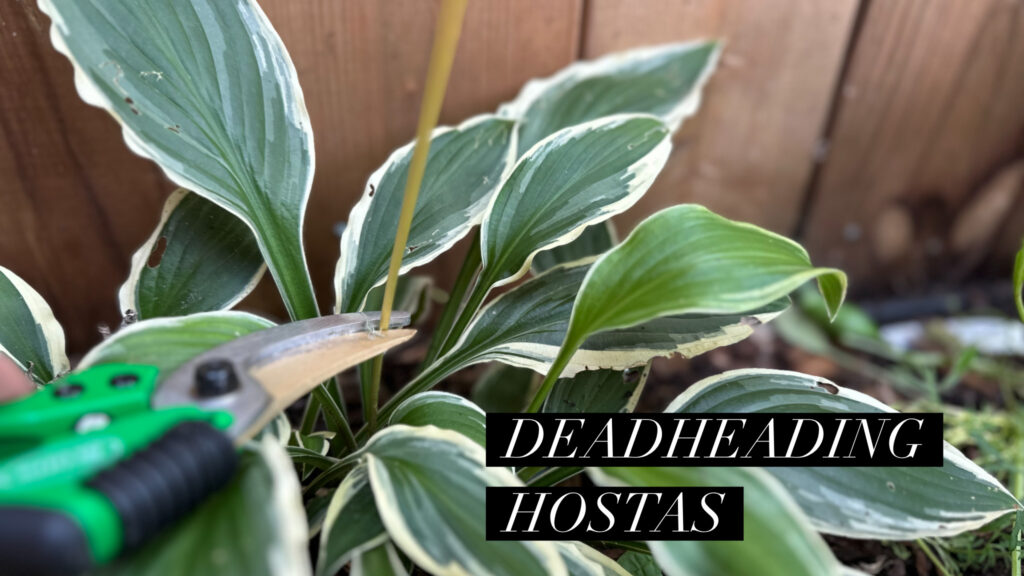Deadheading is one of those things that I know is an important part of gardening but I seem to always let it slip. Especially in the later months of summer. I usually try to spend a few minutes each day going around and either with my hands, or pruners, and clip off the dead flowers. When I do remember, and keep up with it, I can 100% tell the difference it makes to the health of the plant, and to the amount of blooms I get. I have created a quick guide to teach you how to Deadhead and keep you flowers blooming all summer!
“By cutting off these old blooms, it encourages the plant to produce new flowers and promotes healthier growth

What is deadheading?
Deadheading, in gardening and horticulture, refers to the practice of removing spent or faded flowers from a plant. By cutting off these old blooms, it encourages the plant to produce new flowers and promotes healthier growth. Deadheading prevents the plant from diverting energy into seed production and redirects it towards producing more flowers, prolonging the flowering season and enhancing the overall appearance of the plant.
What plants need to be deadheaded?
Many flowering plants can benefit from deadheading to encourage more blooms and maintain their overall appearance. Some common plants that often require deadheading include:
Roses: Regular deadheading of roses promotes continuous flowering and helps keep the bushes looking neat.
Petunias: Deadheading petunias prevents seed formation and encourages more flowers throughout the growing season.
Marigolds: Removing spent flowers from marigolds encourages them to produce more vibrant blooms.
Geraniums: Deadheading geraniums helps maintain their shape and encourages continuous flowering.
Pansies: Deadheading pansies prevents them from going to seed and encourages more blooms.
Zinnias: Regularly removing faded flowers from zinnias prolongs their blooming period and keeps the plants looking attractive.
Dahlias: Deadheading dahlias encourages more blooms and prevents seed formation.
Salvia: Deadheading salvias promotes additional flowering and keeps the plants tidy.
Keep in mind that not all plants require deadheading, and the frequency and method of deadheading may vary depending on the specific plant species. It’s always a good idea to research the particular needs of the plants in your garden to ensure proper care and maintenance.

How to Deadhead
Deadheading flowers is a gardening technique used to remove spent or faded flowers from plants. This not only improves the plant’s appearance but also encourages further blooming and prevents the plant from putting energy into producing seeds. Here’s how you can deadhead flowers:
Choose the Right Time: Deadhead flowers when the blooms start to fade and wilt. This is usually after the flowers have fully opened and begun to lose their vibrant colours.
Inspect the Plant: Examine the plant and identify the flowers that are no longer looking their best. These are the ones you’ll be removing.
Tools: You can deadhead flowers using your fingers, small pruners, or scissors. Use clean and sharp tools to avoid damaging the plant.
Method:
- Pinching: For many plants like petunias or marigolds, you can simply pinch off the spent flower heads with your fingers. Pinch just above the first set of healthy leaves or buds.
- Pruning: For plants with more substantial stems, use pruners or scissors. Cut the stem just above a healthy leaf node or set of leaves. Make the cut at a 45-degree angle to prevent water from collecting on the cut surface.
- Shearing: Some plants benefit from shearing, which involves cutting back the entire plant or a portion of it. This is often done for plants that have multiple small flowers, like some types of geraniums.
Clean Up: Collect the removed flower heads and dispose of them. This helps prevent the buildup of disease or pests in the garden.
Regular Deadheading: Keep an eye on the plant throughout its blooming period and continue deadheading as needed. Regular deadheading encourages the plant to put more energy into producing new blooms rather than seeds.
Exceptions: Some plants, particularly those that produce attractive seed heads or that are grown for their seed pods (like poppies or ornamental grasses), may not need deadheading. In these cases, leave the spent flowers on the plant until they’ve fully matured and developed seeds.
Fertilizing: After deadheading, consider applying a balanced liquid fertilizer to help promote new growth and flowering.
Remember, different plants may have specific deadheading requirements, so it’s a good idea to research the particular plant species you’re dealing with to ensure you’re using the right technique.

Deadheading Hostas
Once the Flowers have spent on your Hosta, cut the stem back as far as you can, this will clean up the look and promote growth back to the roots
What happens if you don’t deadhead?
If you don’t deadhead your plants, several consequences may occur:
Reduced Flowering: Failing to deadhead means the plant will channel its energy into producing seeds instead of new flowers. This can lead to a decrease in the number of blooms and a shorter overall flowering period.
Seed Production: When flowers are not deadheaded, they will naturally form seeds. While this can be desirable in some cases (e.g., for saving seeds or propagating new plants), excessive seed production can divert the plant’s energy away from flower production and lead to a less vibrant display.
Untidy Appearance: Plants with spent and faded flowers can look untidy and detract from the overall beauty of your garden or landscape.
Pests and Disease: Dead flowers can attract pests and may also create a favourable environment for fungal diseases if they remain on the plant for an extended period.
Weakening of Plant: Without deadheading, the plant may exhaust its resources trying to sustain seed production, leading to weakened growth and increased vulnerability to stressors like extreme weather or pests.
Overall, deadheading is a simple and effective gardening practice that encourages continued flowering, improves the appearance of plants, and promotes overall plant health. By regularly removing spent flowers, you can help your plants thrive and enhance the beauty of your garden.

Leave a Reply